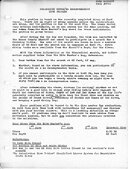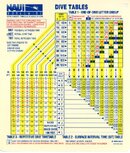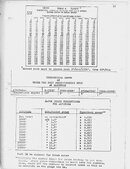This was described for me with 1cm cubes stacked on top of each other 10m high. This picture works for me. This stack equals 1l. 1l of water is 1kg. 1kg/cm2 is approx 1bar, is approx 1 atmosphere, is approx 10m water, is approx 33ft.All of that is supposed to be taught in the first part of the scuba class. Students should know all that long before they are taught either tables or computers.
How does learning tables teach you that 33 feet is two atmospheres?
You are using an out of date browser. It may not display this or other websites correctly.
You should upgrade or use an alternative browser.
You should upgrade or use an alternative browser.
Info Why are tables not taught in OW classes anymore?
- Thread starter tursiops
- Start date
Please register or login
Welcome to ScubaBoard, the world's largest scuba diving community. Registration is not required to read the forums, but we encourage you to join. Joining has its benefits and enables you to participate in the discussions.
Benefits of registering include
- Ability to post and comment on topics and discussions.
- A Free photo gallery to share your dive photos with the world.
- You can make this box go away
Many new divers have been trained only to use dive computers; they have had no introduction to or any familiarity with dive tables.
Many posts on ScubaBoard respond to posts about “what do I do if my computer fails” with the statement, “just use tables.”
This is a disconnect….
Here is the deal on tables, why they have pretty much disappeared from recreational diving, and why the idea of tables (and sometimes their use) is still valid.
Both dive tables and dive computers try and estimate the amount of nitrogen you have absorbed into your body as a result of the amount of time you have spent at depth (i.e., under pressure). It is the (greater than atmospheric) ambient pressure at depth that pushes the nitrogen into your tissues and blood, and with more time spent at that depth, more nitrogen gets pushed in.
The models that try and track this “on-gassed’ nitrogen are mathematically messy. Most of them assume that your body is composed of a number of different tissue types, co-called “compartments,” some of which absorb the nitrogen more quickly, others more slowly; and, each of these compartments has a maximum amount of nitrogen it can absorb. There is a lot to keep track of. While you are underwater at some depth breathing compressed gas, your body is absorbing all this nitrogen, and then when you ascend the nitrogen begins to “off-gas,” which it can only do at the same rate at which it on-gassed, which of course is a different rate for each of the assumed compartments!
When the dive tables were first developed, there were no electronic computers like we have today. Everything was done by hand using mechanical calculators and pencil and paper. Consequently, the table-makers wanted to keep it as simple as possible, so the tables were for “square profile” dives, meaning you descended to a depth, stayed at that depth for the duration of the dive, and ascended. That was OK at the time, because there were no real recreational divers swimming up and down and around coral heads looking at pretty fish and investigating wrecks, and working dives (Navy and commercial) tended to actually be square profiles; everything was fine with tables.
The down-side for square profiles was that the amount of gas used was based on being at the maximum depth for the entire dive, until you ascended, so it was common to run out of gas before hitting your No Decompression Limits. This was also fine, because there was less worry about the “accuracy” of the NDL calculations.
Those early dive tables (for example, the US Navy dive tables) had another assumption built-in that was rather restrictive for recreational divers; the slowest compartment (the one that “controlled” your on-gassing buildup of nitrogen, and your off-gassing rate) was deemed to have a time-constant of 120 minutes. This meant that the surface interval between dives when you were doing a multi-dive day had to be rather long….or you were not doing much off-gassing.
Diving Science And Technology (DSAT), a corporate affiliate of PADI -- starting in the mid-1980s -- rethought recreational dive tables based on using a 60-minute compartment (instead of 120 minutes) as the controlling compartment; using other modern technologies (like Doppler bubble sensing and electronic computers) they developed the Recreational Dive Planner (RDP), which allowed for shorter surface intervals and more granularity in the on- and off-gassing calculations. That model – originally available only in standard dive tables – also became embedded in an electronic hand-calculator version of the table, in an analog circular slide-rule version (The Wheel), and finally in several dive computers, where it is known as the DSAT algorithm.
The big advantages of DSAT and the RDP model over previous models were that (1) it was specifically for non-deco diving, so did not need to have embedded in it any additional conservatism for decompression diving, and (2) since the controlling compartment was only 60 mins, surface intervals could be shorter and thus single-day repetitive diving was made more realistic and easier.
The huge advantage of having the gas on-gassing and off-gassing tracked by a computer that you work on your wrist (or had in a console) was that you could track your actual dive, with its ups and downs, and not be forced into a square-profile assumption. As a consequence, instead of going to (say) 80 feet and spending your entire dive there, you could stay a few minutes at 80, come up to 60 for a while, then 40 for a while, back down to 60, then up to 20 for a while….and your dive computer was with you and tracking (with its model) your on-gassing and off-gassing. Nice.
There are many dive computers using a number of different models, but they all work roughly the same and all track your movements up and down in the water. Consequently, with a dive computer you get longer dives than you can by assuming a square profile on a table, and you get shorter surface intervals before the next dive. Win-Win.
Today, dive tables are rarely taught in OW classes because they are tedious to use, and give considerably less information than your dive computer. However, many argue that dive tables help you to understand the on-gassing/off-gassing better, because they don’t bury everything into a small electronic device with just a (sometimes) complicated display on the front. True or not, they have pretty much gone away for recreational diving. Few know how to use dive tables, and they can easily be used incorrectly.
BUT, what happens if you are on a dive trip and your nice dive computer fails, perhaps during a dive? Best Practice, you immediately end the dive and surface, because you now do not know your depth nor how long you’ve been there, so you ascend and end the dive. Worse, you now do not know your nitrogen status…so if you want to do another dive you need to account for that residual nitrogen….and if you can’t do that, then you should stay out of the water for 24h to let your body “reset” to having completely off-gassed.
Is there anyway around being in the “penalty box” for a day? Yes, there are two ways, one is certain, one is problematic. Certain: carry a second dive computer with you on all dives, so it is a backup that knows your nitrogen status and can be used if your primary fails. Problematic: revert to dive tables. Attempt to work out a version of the dives so far today before your computer failed, and use the table to estimate your nitrogen status. Here is the problem with reverting to dive tables: suppose your computer failed on dive one of the day, and you had gone down to 80 ft for a while, then up to 60 to see the super-structure of a wreck, then up to 40 to spend some time on the reef, and were just getting ready to go to your safety stop about 50 minutes into the dive….and your computer failed. You can surface and end the dive (just don’t go up too quickly), but your square-profile equivalent dive for using tables is 80 ft for 50 minutes. But, the RDP table maxes out at 30 minutes at 80 ft. The dive you just did cannot be done on tables….the tables say you are in decompression status! THAT is the problem with trying to revert to tables,; maybe you can, but often you cannot.
And this is why tables are not taught any more in most OW classes. They do not suit the kind of diving that recreational divers do.
For the same reason Abacus and Slide Rule aren’t taught anymore: Progress and Innovation.
Nothin' to do with tables vs computers; but I was in a classroom for AVID tutoring, and a student asked me for the time. So I showed him my Seiko Dive Watch (analog). He said, "I can't read that!" So I said, "Okay, your a pilot, and someone shouts into the intercom 'Bogy, 10:00 high!' where are you going to look?" He gave me this puzzled look.Tables aren't hard, even the Nitrox ones, really. If I can do it....But of course they are pretty much impossible to use unless you use them regularly, and if not, review them now and then. They are still quite practical for me as almost all my dives are square profiles. Things have evolved though, as Tursiops points out. On a Band directors' forum recently someone said some of their kids can't read an analog clock.
SeaRat
You guys and gals know that this is because much of what is taught now assumes that the diver is going to go to a dive resort and dive tropical. That costs a lot, so a second computer can be justified. But also know that with this assumption, the dive industry is trying to sell the diver more equipment than that diver really needs.I view the cost of that second computer as insurance against missing any dives should the primary computer fail. Dive trips are just too expensive to not be diving on them!
So, how does a dive computer fail? Well, my Suunto Cobra, after a few years, developed a high pressure leak in the line to the computer. That line was replaced, free, but if I had been out somewhere in Australia, on a boat, it would have been all over for that computer.
Now, I grew up on tables. I dive mostly a square profile, and shallow water. So spare tables would be just fine for me. Also, I don't do dive travel, to anywhere. So a computer failure would simply be a cancellation of a local dive. Or, I would simply use my tables to determine the second dive residual nitrogen times, and dive the second dive using the tables.
SeaRat
Eric Sedletzky
Contributor
That sounds about like me.You guys and gals know that this is because much of what is taught now assumes that the diver is going to got to a dive resort and dive tropical. That costs a lot, so a second computer can be justified. But also know that with this assumption, the dive industry is trying to sell the diver more equipment than that diver really needs.
So, how does a dive computer fail? Well, my Suunto Cobra, after a few years, developed a high pressure leak in the line to the computer. That line was replaced, free, but if I had been out somewhere in Australia, on a boat, it would have been all over for that computer.
Now, I grew up on tables. I dive mostly a square profile, and shallow water. So spare tables would be just fine for me. Also, I don't do dive travel, to anywhere. So a computer failure would simply be a cancellation of a local dive. Or, I would simply use my tables to determine the second dive residual nitrogen times, and dive the second dive using the tables.
SeaRat
I pretty much dive locally only and for most shore dives don’t really need a computer. Air supply pretty much determines the length of my dives not depth. I’m still using a 20 yo Uwatec bottom timer that somehow still works.
Tracerbullet
Contributor
I had to learn tables and figure out problems using them to certify (last year)
Okay, for anyone interested, here's a Parerescue Reped/No Decompression Dive Problem for you. I'll give you all that you need to answer it. This was actually given to the 304th Aerospace Rescue and Recovery Squadron Pararescue Team in 1974. If you wish, you can decide whether to do this problem assuming that the dives were all at Clear Lake, Oregon at an altitude of 4,000 feet.
SeaRat
PS, this problem is actually an exercise to appreciate dive computers. Having spent time in occupational safety and health in the high tech industry, I feel that I had a hand in getting these next-generation computers into divers hands too (by ensuring that the engineers, technicians and computer experts that put together those chips went home at the end of the day, without health effects from the chemicals they were handling, and without burns from the Class IV lasers that were used to etch the plates that contained a map for one layer of a computer chip).
SeaRat
PS, this problem is actually an exercise to appreciate dive computers. Having spent time in occupational safety and health in the high tech industry, I feel that I had a hand in getting these next-generation computers into divers hands too (by ensuring that the engineers, technicians and computer experts that put together those chips went home at the end of the day, without health effects from the chemicals they were handling, and without burns from the Class IV lasers that were used to etch the plates that contained a map for one layer of a computer chip).
Attachments
There is another reason to teach/learn tables: to develop the mental habit of maintaining ongoing situational awareness during the course of a dive.
When time and student aptitude/curiosity permit, I try to squeeze in a quick overview of how the tables are built even for students who choose the computer version of the e-learning. I want them to have an idea of what they expect to see on their dive computers before they look at them, and a basic understanding of the tables helps them know how the numbers will move during their dives.
When time and student aptitude/curiosity permit, I try to squeeze in a quick overview of how the tables are built even for students who choose the computer version of the e-learning. I want them to have an idea of what they expect to see on their dive computers before they look at them, and a basic understanding of the tables helps them know how the numbers will move during their dives.
You are very lucky because none of the three I ever had lasted more than 6-7 yrs.I’m still using a 20 yo Uwatec bottom timer that somehow still works.
They can fail anytime without any warning.
We need the log of your dives from earlier that day to complete the problem.Okay, for anyone interested, here's a Parerescue Reped/No Decompression Dive Problem for you. I'll give you all that you need to answer it. This was actually given to the 304th Aerospace Rescue and Recovery Squadron Pararescue Team in 1974. If you wish, you can decide whether to do this problem assuming that the dives were all at Clear Lake, Oregon at an altitude of 4,000 feet.
SeaRat
Similar threads
- Replies
- 4
- Views
- 1,166
- Replies
- 135
- Views
- 4,945
- Replies
- 24
- Views
- 1,735
- Replies
- 319
- Views
- 17,459






